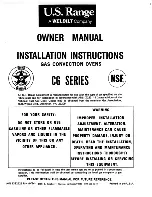
R403KKT
11 – 6
3. Insert a putty knife (thickness of about 0.5mm) into the gap
between the door stopper and the choke cover to free engaging
parts as shown in Figure C-4.
4. Try the principles of the lever and lift up the door stopper.
5. Now, the door stopper is free from the door assembly.
6. Release two (2) pins of door panel from two (2) holes of upper and
lower oven hinges by lifting up.
7. Now, door panel is free from oven cavity.
8. Insert a putty knife (thickness of about 0.5mm) into the gap
between the choke cover and door frame as shown in Figure C-4 to
free engaging parts.
9. Pry the choke cover by inserting a putty knife as shown Figure C-4.
10.Release choke cover from door panel.
11.Now choke cover is free.
NOTE:
When carrying out any repair to the door, do not bend or
warp the slit choke (tabs on the door panel assembly) to
prevent microwave leakage.
Figure C-4. Door Disassembly
12.Slide latch head upward and remove it from door frame with releas-
ing latch spring from door frame and latch head.
13.Now, latch head and latch spring are free.
14.Release door panel from nine (9) tabs of door frame by sliding door
panel downward.
15.Now, door panel with sealer film is free.
16.Tear sealer film from door panel.
17.Now, door panel is free.
18.Remove door screen from door frame.
19.Now, door screen is free.
2. REINSTALLATION
1. Reinstall door screen to door frame.
2. Put sealer film on door panel. Refer to “Sealer Film” about how to
handle new one.
3. Reinstall door panel to door frame by fitting nine (9) tabs of door
frame to nine (9) holes of door panel.
4. Reinstall the latch spring to the latch head. Reinstall the latch
spring to the door frame. Reinstall latch head to door frame.
5. Reinstall choke cover to door panel by pushing
6. Catch two (2) pins of door panel on two (2) hole of upper and lower
oven hinges as shown Figure C-5.
7. Re-install the door stopper to the door assembly.
NOTE:
After any service to the door;
1)
Make sure that door sensing switch and primary interlock
switch are operating properly. (Refer to chapter “Test Proce-
dures”.).
2)
An approved microwave survey meter should be used to
assure compliance with proper microwave radiation emission
limitation standards.
3. After any service, make sure of the following:
1. Door latch heads smoothly catch latch hook through latch holes
and that latch head goes through center of latch hole.
2. Deviation of door alignment from horizontal line of cavity face plate
is to be less than 1.0mm.
3. Door is positioned with its face pressed toward cavity face plate.
4. Check for microwave leakage around door with an approved micro-
wave survey meter. (Refer to Microwave Measurement Procedure.)
NOTE:
The door on a microwave oven is designed to act as an
electronic seal preventing the leakage of microwave
energy from oven cavity during cook cycle. This function
does not require that door be air-tight, moisture (conden-
sation)-tight or light-tight. Therefore, occasional appear-
ance of moisture, light or sensing of gentle warm air
movement around oven door is not abnormal and do not
of themselves indicate a leakage of microwave energy
from oven cavity.
Figure C-5. Door Replacement
4. SEALER FILM
1. Put the adhesive tape on the backing film of the sealer film as
shown in Fig. C-6.
2. Tear the backing film by pulling the adhesive tape.
3. Put the pasted side of the sealer film on the door panel.
Figure C-6. Sealer film
4
3
2
1
5
6
7
9
8
10
11
12
13
Choke Cover
Door Frame
Putty Knife
Door stopper
Pin
Pin
Upper oven hinge
Lower
oven
hinge
Lower
oven hinge
Door
stopper
Choke
cover
Door
assembly
Sealer film
Backing film
Adhesive tape










































